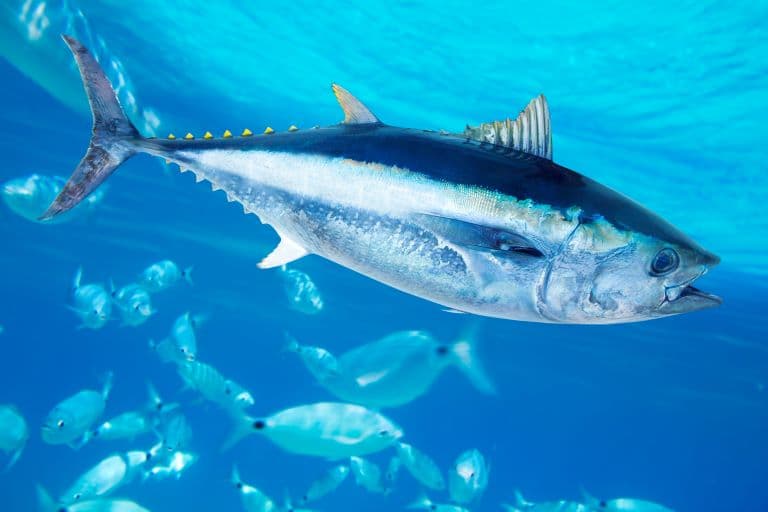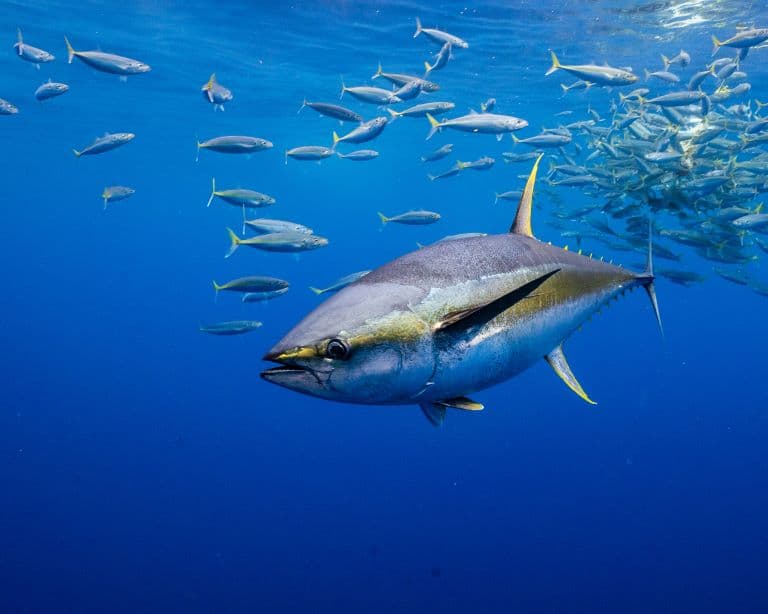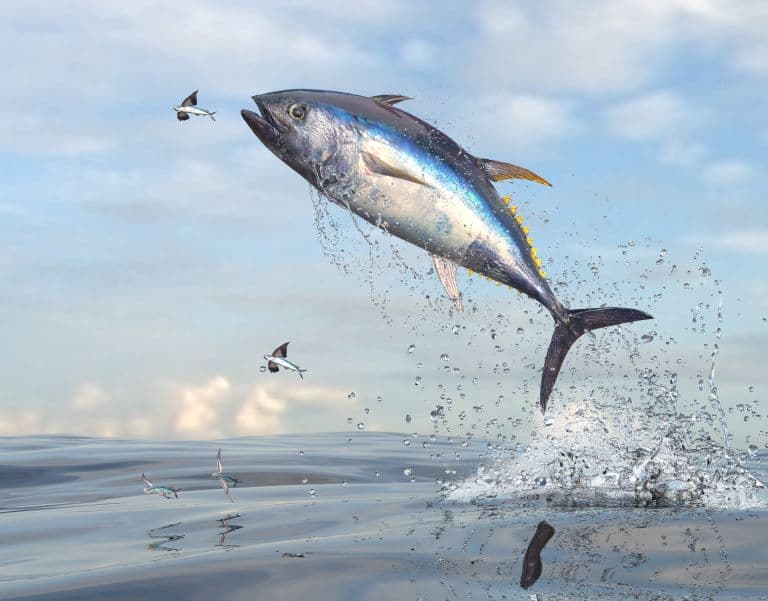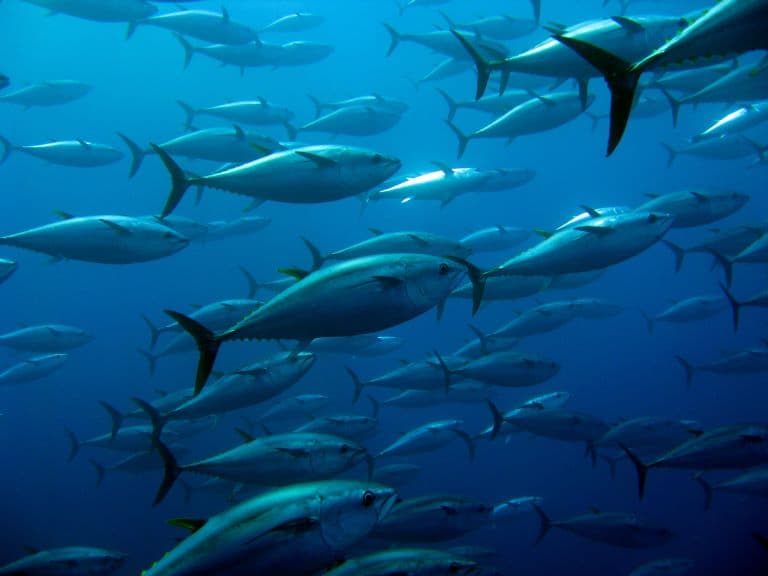Tuna Profile
Perhaps the most misunderstood fish spends its life as an apex predator, chasing down prey at incredible speed and dominating the pelagic oceans as one of the largest and most powerful bony fish in the world.
These incredible hunters then fall prey to the international longline fisheries, ending their existence as a much more familiar tinned commodity, feasted upon by people who know nothing of the glory and prowess they once had.

Tuna Facts Overview
| Habitat: | Tropical and temperate marine |
| Location: | Worldwide |
| Lifespan: | Up to 40 years or more |
| Size: | Up to 4.6m (15 ft) long |
| Weight: | Up to 900 kg (2,000 lb) |
| Colour: | Varied: often blues and yellows |
| Diet: | Fish, cephalopods |
| Predators: | Few, some sharks, orcas, humans |
| Top Speed: | Possibly up to 33 mph (53 kph) |
| No. of Species: | 8-15 |
| Conservation Status: | Least Concern to Endangered (Southern Bluefin, IUCN) |
Tunas make up between eight and fifteen species (depending on how strict your definition is) of pelagic, fast-swimming predatory fish. They’re also one of the most commercially sought-after animals, which has led to catastrophic declines in both the target species and anything unlick enough to be around them at the time.
And this is much more of a tragedy than people are letting on, as the removal of apex predators from any ecosystem causes devastation to their native habitats.
Interesting Tuna Facts
1. True tunas
The genus Thunnus houses eight species of what’s called true tuna. Five of these are bluefin tuna, and three are yellowfin. Until recently, Atlantic and Pacific bluefins were grouped as the same species, but detailed research has shifted the consensus toward them being separate species after all.
Just behind these two groups on the taxonomic branch sits the tribe Thunnini, containing all of the above, and four other genera of tuna, which include smaller varieties like the skipjack and the Little tunny.
Of the true tuna, the yellowfin tuna are large, powerful fish in their own right, but the bluefins are colossal animals.
2. They can be huge
The bullet tuna is the smallest fish in the tribe, reaching a maximum length of about half a metre and topping out at under two kilos in weight.
The Atlantic bluefin tuna, on the other end of the spectrum, is a giant animal, with the heaviest on record weighing 679 kg and reaching almost four meters from nose to tail.
Contrary to the image that’s conjured by the little tins we find them in, some tuna are the largest fish for miles around. Despite this, they’re incredibly agile.

3. They’re built for speed
Tuna are torpedo-shaped, streamlined streaks of high-density muscle, and this is used to accelerate to and maintain competitive speeds against much smaller prey items.
Their dorsal and pelvic fins can be laid down into a groove in their back to reduce drag when necessary and the caudal (tail) fin is crescent-shaped, like the new moon, and so is referred to as Lunate.
This symmetrical fin shape has evolved for speed and the stiff, rigid body reduced energy loss from swinging it back and forth to put more force into moving forward quickly.
The trouble with moving fast through the water is that if you move faster than the water can get out of the way, you create negative pressure, and inside these spots of negative pressure, gases are pulled out and create bubbles. This is known as cavitation, and it can be harmful to the delicate tissues of high-speed fish.
Scombrids like tuna are thought to occasionally cross this threshold, having no pain receptors in their fins, and have been seen with damage attributed to it. So, these are some of the fastest fish in the ocean. 1
4. They’re powerful
Their speed comes from dark red myotomal muscles in their flesh. These tissues have high myoglobin for binding oxygen and essentially providing high-octane fuel to the generators of power inside the fish.
The result is a fast and strong animal and one of the most effective ocean predators. 2 3

5. They’re partially warm-blooded
One of the ways they’re able to generate such impressive power is by warming up the necessary regions of their body above ambient temperatures.
Very few fish can do this, and tuna are one of them. They can channel hot blood to their swimming muscles, giving them an edge on their cold-blooded prey, and allowing them to move from warm water into cold waters without slowing down. 4
6. They’re long-distance swimmers
With this high energy output comes an even higher need for energy input. Tuna are exceptional predators but that comes at the cost of needing to eat a lot more than some of their cold-blooded competitors.
This means tuna are always on the move. They take on some impressive migrations, some traversing the distance between North America and Europe multiple times in a year.
Bluefins don’t just move laterally, either. They’ve been tagged descending to 2.5km into the inky blackness of the deep ocean in search of food, and others move up and down in the water column daily, returning to the surface at night. 5

7. There is no such thing as “Dolphin safe”
Tuna is most commonly recognised as a food and one that’s got a long history in various seafood-eating cultures. Skipjack is the most fished by a wide margin, representing up to 699o==0% of all catches globally.
These make up most of what you’ll see in tins on the supermarket shelf, and their catch comes at a great cost, not only to the target species, but all the animals brought up and killed alongside them by mistake.
Dolphins are well-known victims of the tuna fishing industry, and attempts have been made to placate an increasingly-concerned consumer base by presenting them with the fallacious “dolphin-safe tuna” option.
The truth is, no amount of industrial fishing will ever be dolphin safe; cans with labels merely mean that a particular style of fishing wasn’t used in a particular part of the ocean. This is a deliberate fraud, designed to mislead the consumer.
Kills may be reduced by using longlines instead of nets, but a lack of enforcement and willful neglect of safe disposal of fishing gear result in what’s known as “ghost nets”: large clusters of entangled fishing gear that never decompose and float around the ocean for hundreds of years, snaring dolphins, whales, turtles, and fish for thousands of generations.
Tuna Fact-File Summary
Scientific Classification
| Kingdom: | Animalia |
| Phylum: | Chordata |
| Class: | Actinopterygii |
| Order: | Scombriformes |
| Family: | Scombridae |
| Tribe: | Thunnini |
Fact Sources & References
- G Iosilevskii (2007), “Speed limits on swimming of fishes and cetaceans”, The Royal Society.
- Rayyan Ibrahim (2020), “Don’t Eat Tuna: We are killing the ocean’s most effective predators”, Medium.
- Author Name (Year), “Article Name”, Publication.
- “Tuna”, National Geographic.
- “Pacific Bluefin Tuna Migration”, Smithsonian.
